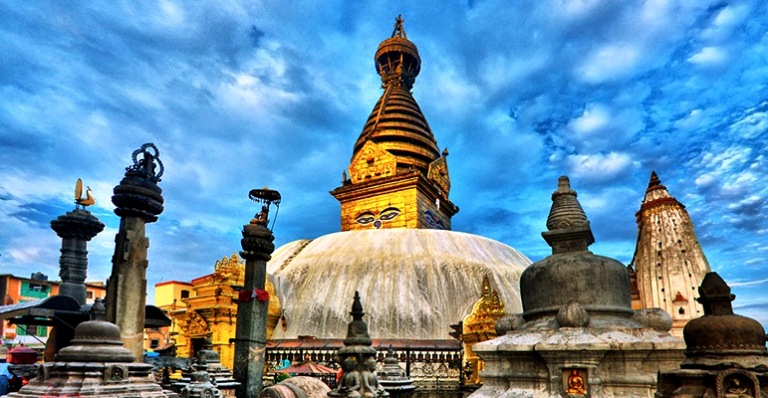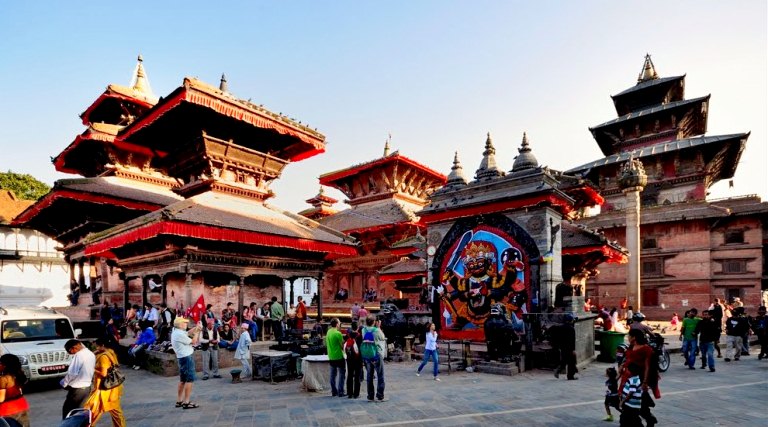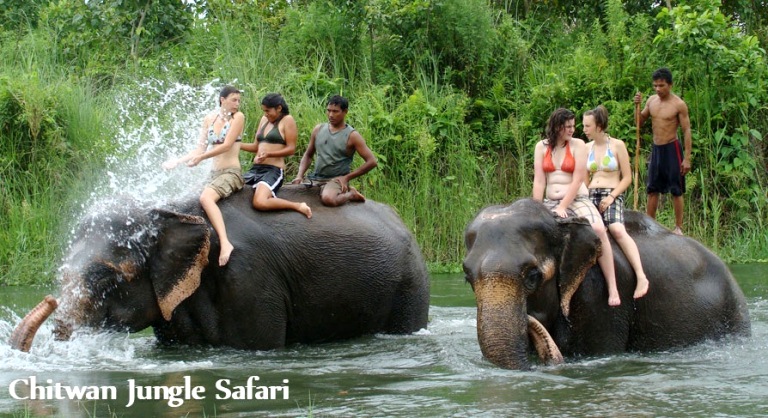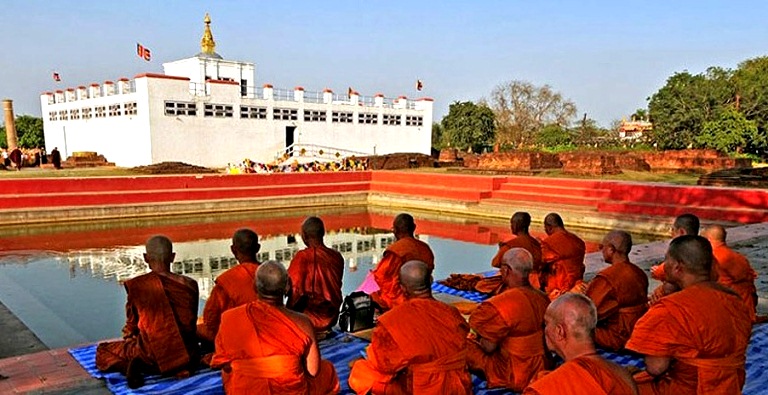
OVERVIEW- Buddhism is one of the most primitive and the largest religions of the world. This religion has been thrived in India from the 3rd century BC. India and Nepal are two different countries but share a common factor that is associated with the life of Lord Buddha. While Lumbini and Kapilvastu bear testimony to the birth and adulthood of Prince Siddhartha, the rest of the destinations witnessed the transformation of a prince into Buddha-The Awakened One. India Nepal Buddhist Tour will cover the prominent Buddhist sites sprinkled across different parts of India and Nepal like Bodhgaya, Rajgir, Nalanda, Patna, Vaishali, Kushinagar, Lumbini, Kapilavastu, Sravasti, Varanasi and Sarnath along with gilded tour of Delhi, Kathmandu & Chitwan. All the sacred sites have been associated with Lord Buddha right from his birth to the rise of Buddhism in India.
DELHI- New Delhi, capital of India is a mix of the ancient and modern architecture. This 3rd largest city of India unwinds a picture rich with culture, architecture, and human diversity. Divided in two parts, Old Delhi & New Delhi, the city is a travel hub of Northern India and exerts a beguiling charm on visitors.
KATHMANDU- Kathmandu is the capital and the only metropolitan city of Nepal. The Kathmandu region is essentially a valley, surrounded by 4 prominent hills. The city boasts of a huge amount of temples and spiritual places, making it a rather serene experience for the traveller.
CHITWAN- At the foot of the Himalayas, Chitwan is one of the few remaining undisturbed vestiges of the 'Terai' region, which formerly extended over the foothills of India and Nepal. It has a particularly rich flora and fauna. One of the last populations of single-horned Asiatic rhinoceros lives in the park, which is also one of the last refuges of the Bengal tiger.
LUMBINI- Lumbini is one of the holiest places of one of the world's great religions, and its remains contain important evidence about the nature of Buddhist pilgrimage centers from as early as the 3rd century BC. Lumbini, situated in the southern Nepal is a sacred site as Lord Buddha was born here.
KUSHINAGAR- Nestled in the heart of Uttar Pradesh; Kushinagar is one of the ancient towns that attract people from all over for its beautiful Stupas and Temples. Kushinagar is a place where Lord Buddha attained Nirvana. It is famous for numerous monasteries and stupas dating back years ago are almost in relics now.
VAISHALI- Vaishali is deemed to be the embrace of people of two main religions of India which are Buddhism and Jainism. This place is supposed to be the oldest republic of the world. Vaishali is the birth place of Lord Mahavira, Lord Buddha preached his last sermon here and Emperor Ashoka erected a lion column to commemorate the occasion.
PATNA- Prospering along the southern banks of river Ganges and set in the conglomerated backdrop of rich ancient heritage and a glorious historical past, Patna boasts of a dominating presence in history and enjoys the distinction of being one of the oldest cities in the world. Originally called as Pataliputra, Patna is currently a hot-bed for the culminating political fortunes.
RAJGIR- Rajgir is town where the air that surrounds its beautiful sceneries carries hints of spirituality and vibrant hues of history with links with both Buddhism and Jainism. Set in a green valley and surrounded by rocky hills, Rajgir is a spiritual town with natural serenity amongst the dense forests, mysterious caves and springs. Both Lord Buddha and Lord Mahavir have said to spent time here giving Rajgir a huge spiritual and religious importance.
NALANDA- Nalanda is located in the eastern Indian state of Bihar. It is well known as the ancient centre of learning which has the remains of the great Nalanda University and several monasteries and temples. Both Lord Buddha and Mahavira visited this place and it remained a renowned learning centre till 12th century.
BODHGAYA- Gaya is the most symbolic city of Bihar. From being the birthplace of Buddhism to sharing deep bond with Hinduism and Jainism it is one of the major pilgrimage sites for Hindus and Buddhists. Its natural surroundings, narrow by lanes and its age old buildings make it special. Gaya is important for Buddhists as Buddha preached the Fire Sermon at Brahmayoni Hill, which was earlier called Gayasisa.
Tour Destination: Delhi - Kathmandu - Chitwan - Lumbini - Kushinagar - Vaishali - Patna - Rajgir - Nalanda - Bodhgaya - Delhi
Travel Duration: 12 Nights/13 Days
DAY 1: DELHI
Arrive in Delhi and later transfer to the hotel. In the evening you can enjoy local activities and shopping the local markets.
Overnight at Hotel.
DAY 2: DELHI
Arrive in Delhi and later transfer to the hotel. Later enjoy full day city tour of Old Delhi & New Delhi visiting
RED FORT- This is a magnificent fort with beautiful artwork of red sandstone on the banks of river Yamuna. It is a huge complex of gardens and pavilions and marble palaces.
JAMA MASJID- This is the largest mosque in India, located opposite to the Red Fort, it was again the great Mughal Emperor Shah Jahan behind this architectural masterpiece.
RAJ GHAT- Built on the banks of the legendary Yamuna, which flows past New Delhi, Raj Ghat-the last resting place of Mahatma Gandhi, the father of the nation.
INDIA GATE- Built as a memorial to commemorate the 70,000 India soldiers killed in World War I, India Gate was designed by Sir Edwin Lutyens and completed in 1931. The green, velvety lawns at India Gate, particularly, are a popular evening and holiday rendezvous for young and old alike.
PRESIDENT'S HOUSE- New Delhi, centers around the Rashtrapati Bhawan. It is architecturally a very impressive building standing at a height, flowing down as it were to India Gate.
HUMAYUN'S TOMB- The emperor's grieving widow, Haji Begum, built Humayun's Tomb the first mature example of Mughal architecture in India, in 1565 AD.
LAXMI NARAYAN TEMPLE- Also called the Birla Mandir it was built in 1938; the temple is an ideal introduction to some of the gods of the India pantheon.
LOTUS TEMPLE- The Bahai's Temple, is shaped like a lotus. It is an eye-catching edifice worth exploring. Built by the Bahai's community, it offers the visitor a serenity that pervades the temple and its artistic design.
QUTAB MINAR- It is among the tallest and famous towers in the world. Qutab Minar is famed as the highest brick minaret of the world, located amidst the lush greens of South Delhi.
Overnight at Hotel.
DAY 3: DELHI - KATHMANDU
With a beautiful morning, transfer to airport to catch flight to Kathmandu. Spend the rest of the day at leisure or you can go for a leisure walk around the place.
Overnight at Hotel.
DAY 4: KATHMANDU
After breakfast, take a full day city tour of Kathmandu visiting
PASHUPATINATH TEMPLE- Situated on the banks of river Bagmati, Pashupatinath temple is a sacred Hindu temple complex. It is an enormous collection of temples, shrines, ashrams and inscriptions of the region. The sheer size of this entire temple complex makes it quite a remarkable attraction.
BOUDANATH STUPA- Boudanath is a Buddhist Stupa, considered to be the most sacred Stupa by the Tibetan Buddhists. It is absolutely massive in size. It is believed to be the largest stupa in the country and one of the largest in the entire world.
SWAYAMBHU TEMPLE- The temple is an ancient Buddhist stupa in the Kathmandu valley. This temple is situated on a hilltop, west of Kathmandu City, in the valley. It is considered to be one of the oldest and the most sacred religious places in the country.
KATHMANDU DURBAR SQUARE- It is one of three Durbars in the Kathmandu valley located in front of the old royal palace of the Nepal Monarchy. Also known as the Hanuman Dhoka Palace Complex owing to the statue of Lord Hanuman at the entry of the palace.
In the evening you can shop at local markets and visit casinos.
Overnight at Hotel.
DAY 5: KATHMANDU - PATAN - BHAKTAPUR - NAGARKOT - KATHMANDU (SUN SET DAY TOUR)
Today morning go on an excursion to Patan, Bhaktapur and Nagarkot
PATAN- Patan is also known as Lalitpur, "City of Beauty", and its unique Durbar Squares, temples, alleys, cuisine, hospitality and religious tolerance justify the pre-historic status of the city. It is a UNESCO-protected marvel of the Newa architecture.
BHAKTAPUR- Bhaktapur is known as the 'City of Devotees', the 'City of Culture', the 'Living Heritage', and 'Nepal's Cultural Gem'. It is one of the 3 royal cities in the Kathmandu Valley. The place is filled with monuments, most terra-cotta with carved wood columns, palaces and temples with elaborate carvings, gilded roofs, open courtyards. The city is dotted with pagodas and religious shrines. Bhaktapur is surrounded by mountains and provides a magnificent view of the Himalayas.
NAGARKOT- In the evening view the refreshing valleys as well as panoramic mountains. One can visualize the ranges of mountains from west to east including Annapurna, Dhaulagiri, Everest and many more; this is a perfect place for sun set views.
Later return back to Kathmandu.
Overnight at Hotel.
DAY 6: KATHMANDU - CHITWAN NATIONAL PARK
In the morning drive to the famous Chitwan National Park of Nepal which is best known for the Jungle safari activities and adventure. In the evening walk around the place to visualize the flora and fauna.
Overnight at Hotel.
DAY 7: CHITWAN NATIONAL PARK
Today go for a jungle safari in the park on the back of Elephant or 4WD vehicle.
CHITWAN NATIONAL PARK- Chitwan National Park is one of the premier drawcards in Nepal. This World Heritage listed reserve protects more than 932 sq km of forests, marshland and grassland containing sizeable animal populations, making it one of the best national parks for viewing wildlife in Asia. You'll have an excellent chance of spotting one-horned rhinos, deer, monkeys and some of the more than 500 species of birds.
Overnight at Hotel.
DAY 8: CHITWAN - LUMBINI
Today drive to Lumbini, situated in the southern Nepal is a sacred site as Lord Buddha was born here. Transfer to the hotel. Spend the rest of the day at leisure or you can go for a leisure walk around the place.
Overnight at Hotel.
DAY 9: LUMBINI - KUSHINAGAR
After breakfast visit the birthplace of Buddha, Lumbini.
ASHOKA PILLAR- An inscribed pillar by King Ashoka erected in 249 BCE. The inscription on the pillar is the oldest in Nepal. An important site for the history lovers and Buddhists, the site is one of the most visited sites in Nepal.
BUDDHIST TEMPLES- There are foundations of temples from 2 AD to 9 AD throughout the area. Among the many temples in Chinese, Japanese and Burmese architecture, the modern ones are in Nepalese architecture, Lumbini Buddha Vihar and other in Tibetan style, the Dharma Swami Maharaja Buddha Temple.
BODHI TREE- It is a tree covered in prayer flags situated just beside the pond. People come here to make wishes in hope of them becoming true. they tie a flag around the tree per wish. The place is very peaceful and people generally do meditation there.
JAPAN PEACE STUPA- World Peace Pagoda is a 41m high structure situates at the northern end of the Gardens.
Further continue your journey to Kushinagar. Spend the rest of the day at leisure or you can go for a leisure walk around the place.
Overnight at Hotel.
DAY 10: KUSHINAGAR - VAISHALI - PATNA
After breakfast visit ancient town of Kushinagar.
PARINIRVANA STUPA- Excavated in 1867, Parinirvana Stupa is huge stupa made of brick. The stupa has Brahmi inscription on its walls and a reclining Nirvana statue of Buddha inside it.
RAMABHAR STUPA- It marks the place where Lord Buddha received the Mahaparinirvana or the Final Enlightenment. The 15 meters high stupa is one of the major attractions in Kushinagar.
MAHAPARINIRVANA TEMPLE- It is located in the ruins various ancient monasteries which were founded during the 5th century AD. The temple is famous for its 6.10 meters long statue of Lord Buddha. According to the inscriptions in the ruins, the remains of Lord Buddha have been deposited here.
Later drive to Patna enroute visiting Vaishali.
ASHOKA PILLAR- One of the renowned destinations of Vaishali located in proximity to coronation tank, Ashoka Pillar is a lion pillar constructed by King Ashoka. There is also a brick Stupa close to it which is believed to honor the last sermon of Lord Buddha.
BUDDHA STUPA 1- The exterior of this stupa which is now in a dilapidated condition has a plain surface. One-eighth of the sacred ashes of the Lord Buddha were enshrined here in a stone casket.
BUDDHA STUPA 2- Excavation at this site in 1958 led to the discovery of another casket containing the ashes of the Lord Buddha.
Overnight at Hotel.
DAY 11: PATNA - NALANDA - RAJGIR - BODHGAYA
Today morning drive to Rajgir and Nalanda, and further continue to Bodhgaya.
JAPANESE PEACE STUPA- Also known as the Vishwa Shanti Stupa, this pillar is situated atop the Gridhakuta hill at an altitude of 400m. It was built as a symbol of world peace by the Japanese. This marble pillar also showcases four golden statues of Buddha depicting different stages of his life - birth, enlightenment, preaching and death. This location can be accessed by an aerial ropeway.
VULTURE'S PEAK- This was the place where the Lord Buddha set in motion his second wheel of Law and for three months every year during the rainy season, preached many inspiring sermons to his disciples. The Buddha Sangha of Japan has constructed a massive modern stupa, the Shanti Stupa (Peace Pagoda), at the top of the hill in commemoration.
BAMBOO GROVE- King Bimbisara donated the Bamboo Grove, Veluvana to Buddha for his residence. Today, it is a park with admiring sights of bamboos, flowers and a large pond with Buddha's image in the centre.
Further continue your drive to the beautiful city of Nalanda visiting
NALANDA UNIVERSITY- This University is one of the ancient heritage marvels of India that shaped the country's identity as the giver of the knowledge. Spread over an area of 14 hectares, the ruins here feature splendid temples and monasteries built by the patron kings.
NALANDA MUSEUM- Established in 1971, Nalanda Museum houses many ancient antiquities excavated from Nalanda University ruins and also at Rajgir. The antiques here feature many Buddhist and Hindu bronzes, a number of ancient Buddhist manuscripts, coins, pottery and inscriptions of Maurya and Gupta period.
SURYA MANDIR- Located near Nalanda University, Surya Mandir is dedicated to the Sun God and features a number of Hindu and Buddhist idols.
HUIEN TSANG MEMORIAL HALL- This memorial hall is dedicated to the historic Chinese traveller who came who left his home country in pursuit of Buddha and Buddhism to India in the 5th century AD and stayed in Nalanda for 12 years as a student. Also, he served the university as a teacher and studied the social and political conditions in the country. The memorial hall was built in his memory.
In the evening drive to Bodhgaya. Transfer to the Hotel.
Overnight at Hotel.
DAY 12: BODHGAYA
After breakfast visit the holy city of Gaya.
MAHABODHI TEMPLE- The Mahabodhi temple is also called as the "Great Awakening Temple". It is among one of the World Heritage Sites. It is a Buddhist temple in Bodh Gaya, which marks the location where the Buddha, is said to have attained enlightenment. Mahabodhi temple is a historical place at which the Enlightenment of Gautam Buddha took place which later on became a place of pilgrimage.
BODHI TREE- The Bodhi Tree, is perhaps the most prominent and respected sacred places in Buddhism because of the rich historical significance attached to it. It is under this tree that Prince Siddhartha Gautama, the spiritual teacher who later became to be known as the Buddha, attained enlightenment. It is believed that Prince Siddhartha had to sit and meditate under this tree for seven days. Later on, a shrine known as Animisalocana Cetiya was erected on the spot where he had sat down. A small temple was also built near the Bodhi tree in the 7th century.
GREAT BUDDHA STATUE- This statue of Lord Buddha is the tallest in India and was instated by the XIV Dalai Lama in 1989. It is a meditating Buddha resting on a giant lotus, constructed using intricately carved sandstone and red granite.
THAI MONASTERY- Well known for its curved roof covered with exquisite tiles of gold, the Thai Monastery houses a bronze statue of Buddha and another recently erected 25m high statue in the garden.
ROYAL BHUTAN MONASTERY- The Royal Bhutan Monastery has been named so, as it was built by the King of Bhutan as a dedication to Lord Buddha. Clay carvings are seen on the interior walls of the monastery that depict different aspects of the Buddhist culture.
Overnight at Hotel.
DAY 13: BODHGAYA - DELHI
Day free for leisure and later depart at Gaya Airport to catch flight towards onward destination.
Need Aspark Help?
For Tour Packages, Vehicle Rental and Customer Care Support.
+91 9999 31 7846
booking@asparkholidays.comWhy Travel with Us?

Excellent Support
Our Team Available 24x7 for Customer support
Best Price & Savings
We Offer the Most Competitive Prices.



